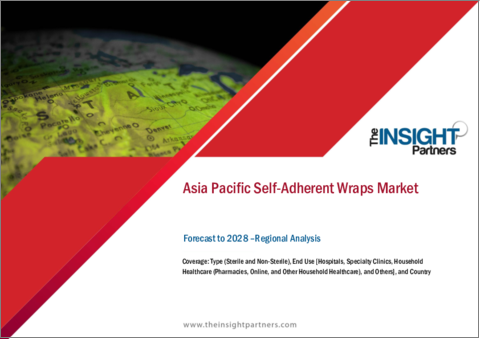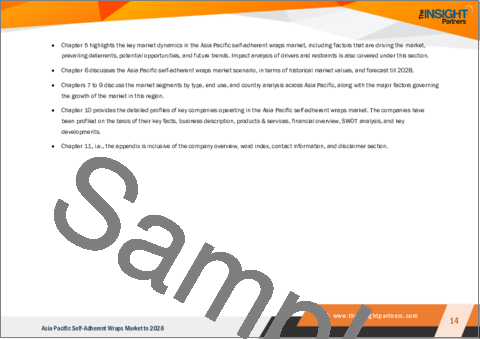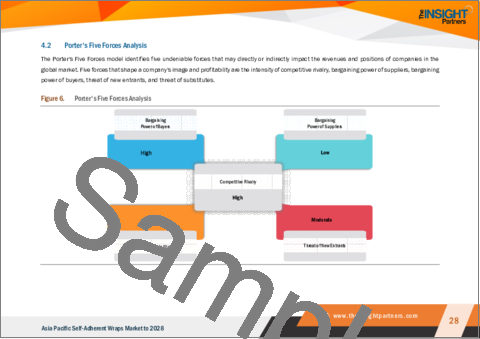|
|
市場調査レポート
商品コード
1375052
アジア太平洋の自着性包帯市場の2028年までの予測-地域別分析-タイプ別、最終用途別Asia Pacific Self-Adherent Wraps Market Forecast to 2028- COVID-19 Impact and Regional Analysis- by Type (Sterile and Non-Sterile) and End Use |
||||||
|
|||||||
| アジア太平洋の自着性包帯市場の2028年までの予測-地域別分析-タイプ別、最終用途別 |
|
出版日: 2023年08月17日
発行: The Insight Partners
ページ情報: 英文 98 Pages
納期: 即納可能
|
- 全表示
- 概要
- 図表
- 目次
アジア太平洋の自着性包帯市場は、2022年の8,583万米ドルから2028年には1億2,010万米ドルに成長すると予測されています。2022年から2028年までのCAGRは5.8%と推定されます。
医療インフラへの投資の増加がアジア太平洋の自着性包帯市場を後押し
世界のさまざまな国が、世界最高水準と専門的治療に沿った医療インフラの強化に注力しています。医療システムの強靭性を強化するための投資は、人々を保護し、医療システムの基盤を強化し、人々により良い医療サービスを提供することを目的としています。例えばインドでは、政府は2018年に包括的なプライマリー・医療を提供するため、アユシュマン・バラット・スキームを開始しました。この制度の一環として、サブ・ヘルスセンター(SHC)、プライマリー・ヘルスセンター(PHC)、アーバン・プライマリー・ヘルスセンター(UPHC)をアップグレードすることで、全国に150万カ所のアユシュマン・バラット・ヘルス&ウェルネスセンター(AB-HWC)が設置されます。2021年3月に発表されたニュースによると、オンタリオ州(カナダの州)政府は、新しいグレイ・ブルース・ヘルス・サービス・マークデール病院の建設に最大4,180万米ドル(5,300万カナダドル)を投資する計画を発表しました。この病院は、旧施設に代わるもので、グレイ郡とその近隣地域の患者や家族の診療能力と医療へのアクセスを向上させることが期待されています。医療インフラへの投資増加の結果、自着性包帯を含む、患者の治療に必要な様々な医療製品の需要が伸びると予想されます。自着性包帯は、救急治療室、集中治療室、手術、創傷治療、循環器、重症患者治療などの用途で使用されます。したがって、医療インフラへの投資の増加は、予測期間中にアジア太平洋の自着性包帯市場の成長に多くの機会を提供すると予想されます。
アジア太平洋の自着性包帯市場概要
アジア太平洋は、人口の着実な増加、人々の可処分所得の増加、一人当たりの医療支出の高さが特徴です。世界保健機関(WHO)によると、2019年の東南アジア(ASEAN)の1人当たり平均医療費は544米ドルで、GDP全体の約4%を構成しています。米国国勢調査局が2022年に発表した報告書によると、アジアの人口は2020年に45億人に達しました。同報告書によると、アジアの65歳以上人口は2020年の4億1,400万人から2060年には12億人に達すると予測されています。自己密着型ラップは、慢性疾患の管理、関節のサポート、創傷の安定化のために高齢者医療で使用されています。このように、医療分野の成長、高齢者人口の急増、スポーツ関連傷害事例の増加が、予測期間中のアジア太平洋の自着性包帯市場の成長を促進すると予想されます。
アジア太平洋の自着性包帯市場の収益と2028年までの予測(千米ドル)
アジア太平洋の自着性包帯市場のセグメンテーション
アジア太平洋の自着性包帯市場は、タイプ、最終用途、国に区分されます。
タイプ別では、アジア太平洋の自着性包帯市場は無菌と非無菌に区分されます。2022年のアジア太平洋の自着性包帯市場では、非滅菌セグメントが大きなシェアを占めています。
最終用途に基づき、アジア太平洋自着性包帯市場は病院、専門クリニック、家庭医療、その他に区分されます。家庭用医療は薬局、オンライン、その他の家庭用医療に区分されます。家庭用医療分野は2022年にアジア太平洋の自着性包帯市場で最大のシェアを占めました。
国別に見ると、アジア太平洋の自着性包帯市場は、オーストラリア、中国、インド、日本、韓国、その他のアジア太平洋に区分されます。その他のアジア太平洋は、2022年のアジア太平洋の自着性包帯市場のシェアを独占しました。
3M Co、Cardinal Health Inc、Essity AB、Medline Industries LP、Performance Health Holding Inc、Steroplast Healthcare Ltd、Walgreens Coがアジア太平洋セルフアダヒレントラップ市場で事業を展開する主要企業です。
目次
第1章 イントロダクション
第2章 キーポイント
第3章 調査手法
- 調査範囲
- 調査手法
- データ収集
- 一次インタビュー
- 仮説の策定
- マクロ経済要因分析
- 基礎数値の作成
- データの三角測量
- 国レベルのデータ
第4章 アジア太平洋の自着性包帯市場情勢
- 市場概要
- ポーターのファイブフォース分析
- 新規参入業者の脅威
- 買い手の交渉力:新規参入の脅威
- 供給企業の交渉力:新規参入の脅威
- 競争企業間の敵対関係
- 代替品の脅威
- エコシステム分析
- 原材料サプライヤー
- 製造業者
- ディストリビューター/サプライヤー
- エンドユーザー
- 専門家の見解
第5章 アジア太平洋の自着性包帯市場:主要市場力学
- 市場促進要因
- 自着性包帯の利点
- スポーツ・フィットネス分野での自着性包帯使用の増加
- 市場抑制要因
- 偽造品の入手可能性
- 市場機会
- 医療インフラへの投資の増加
- 今後の動向
- オンライン薬局の成長
- 影響分析
第6章 自着性包帯のアジア太平洋市場分析
- アジア太平洋の自着性包帯市場概要
第7章 アジア太平洋の自着性包帯市場分析-タイプ別
- イントロダクション
- アジア太平洋の自着性包帯市場:タイプ別(2021年、2028年)
- 滅菌
- 非滅菌
第8章 アジア太平洋の自着性包帯市場分析-最終用途別
- イントロダクション
- アジア太平洋の自着性包帯市場:最終用途別(2021年および2028年)
- 病院
- 専門クリニック
- 家庭用医療
- その他
第9章 アジア太平洋の自着性包帯市場:国別分析
- オーストラリア
- 中国
- インド
- 日本
- 韓国
- その他のアジア太平洋
第10章 企業プロファイル
- 3M Co
- Cardinal Health Inc
- Medline Industries LP
- Essity AB
- Performance Health Holding Inc
第11章 付録
List Of Tables
- Table 1. Asia Pacific Self-Adherent Wraps Market -Revenue and Forecast to 2028 (US$ Thousand)
- Table 2. Australia: Asia Pacific Self-Adherent Wraps Market, by Type- Revenue and Forecast to 2028 (US$ Thousand)
- Table 3. Australia: Asia Pacific Self-Adherent Wraps Market, by End Use - Revenue and Forecast to 2028 (US$ Thousand)
- Table 4. China: Asia Pacific Self-Adherent Wraps Market, by Type - Revenue and Forecast to 2028 (US$ Thousand)
- Table 5. China: Asia Pacific Self-Adherent Wraps Market, by End Use - Revenue and Forecast to 2028 (US$ Thousand)
- Table 6. India: Asia Pacific Self-Adherent Wraps Market, by Type - Revenue and Forecast to 2028 (US$ Thousand)
- Table 7. India: Asia Pacific Self-Adherent Wraps Market, by End Use - Revenue and Forecast to 2028 (US$ Thousand)
- Table 8. Japan: Asia Pacific Self-Adherent Wraps Market, by Type - Revenue and Forecast to 2028 (US$ Thousand)
- Table 9. Japan: Asia Pacific Self-Adherent Wraps Market, by End Use - Revenue and Forecast to 2028 (US$ Thousand)
- Table 10. South Korea: Asia Pacific Self-Adherent Wraps Market, by Type - Revenue and Forecast to 2028 (US$ Thousand)
- Table 11. South Korea: Asia Pacific Self-Adherent Wraps Market, by End Use - Revenue and Forecast to 2028 (US$ Thousand)
- Table 12. Rest of Asia Pacific: Asia Pacific Self-Adherent Wraps Market, by Type - Revenue and Forecast to 2028 (US$ Thousand)
- Table 13. Rest of Asia Pacific: Asia Pacific Self-Adherent Wraps Market, by End Use - Revenue and Forecast to 2028 (US$ Thousand)
- Table 14. Glossary of Terms, Asia Pacific Self-Adherent Wraps Market
List Of Figures
- Figure 1. Asia Pacific Self-Adherent Wraps Market Segmentation
- Figure 2. Asia Pacific Self-Adherent Wraps Market Segmentation - By Country
- Figure 3. Asia Pacific Self-Adherent Wraps Market Overview
- Figure 4. Asia Pacific Self-Adherent Wraps Market, By Type
- Figure 5. Asia Pacific Self-Adherent Wraps Market, by Country
- Figure 6. Porter's Five Forces Analysis
- Figure 7. Ecosystem: Asia Pacific Self-Adherent Wraps Market
- Figure 8. Expert Opinion
- Figure 9. Asia Pacific Self-Adherent Wraps Market Impact Analysis of Drivers and Restraints
- Figure 10. Asia Pacific Self-Adherent Wraps Market - Revenue and Forecast to 2028 (US$ Thousand)
- Figure 11. Asia Pacific Self-Adherent Wraps Market Revenue Share, By Type (2021 and 2028)
- Figure 12. Sterile: Asia Pacific Self-Adherent Wraps Market - Revenue and Forecast To 2028 (US$ Thousand)
- Figure 13. Non-Sterile : Asia Pacific Self-Adherent Wraps Market - Revenue and Forecast To 2028 (US$ Thousand)
- Figure 14. Asia Pacific Self-Adherent Wraps Market Revenue Share, By End Use (2021 and 2028)
- Figure 15. Hospitals: Asia Pacific Self-Adherent Wraps Market - Revenue and Forecast To 2028 (US$ Thousand)
- Figure 16. Specialty Clinics: Asia Pacific Self-Adherent Wraps Market - Revenue and Forecast To 2028 (US$ Thousand)
- Figure 17. Household Healthcare: Asia Pacific Self-Adherent Wraps Market - Revenue and Forecast To 2028 (US$ Thousand)
- Figure 18. Pharmacies: Asia Pacific Self-Adherent Wraps Market - Revenue and Forecast To 2028 (US$ Thousand)
- Figure 19. Online: Asia Pacific Self-Adherent Wraps Market - Revenue and Forecast To 2028 (US$ Thousand)
- Figure 20. Other Household Healthcare: Asia Pacific Self-Adherent Wraps Market - Revenue and Forecast To 2028 (US$ Thousand)
- Figure 21. Others: Asia Pacific Self-Adherent Wraps Market - Revenue and Forecast To 2028 (US$ Thousand)
- Figure 22. Asia Pacific Self-Adherent Wraps Market, by Key Country- Revenue (2021) (US$ Thousand)
- Figure 23. Asia Pacific Self-Adherent Wraps Market Revenue Share, by Key Country (2021 and 2028)
- Figure 24. Australia: Asia Pacific Self-Adherent Wraps Market -Revenue and Forecast to 2028 (US$ Thousand)
- Figure 25. China: Asia Pacific Self-Adherent Wraps Market -Revenue and Forecast to 2028 (US$ Thousand)
- Figure 26. India: Asia Pacific Self-Adherent Wraps Market -Revenue and Forecast to 2028 (US$ Thousand)
- Figure 27. Japan: Asia Pacific Self-Adherent Wraps Market -Revenue and Forecast to 2028 (US$ Thousand)
- Figure 28. South Korea: Asia Pacific Self-Adherent Wraps Market -Revenue and Forecast to 2028 (US$ Thousand)
- Figure 29. Rest of Asia Pacific: Asia Pacific Self-Adherent Wraps Market -Revenue and Forecast to 2028 (US$ Thousand)
The Asia Pacific self-adherent wraps market is expected to grow from US$ 85.83 million in 2022 to US$ 120.10 million by 2028. It is estimated to grow at a CAGR of 5.8% from 2022 to 2028.
Increasing Investments in Healthcare Infrastructure Fuel Asia Pacific Self-Adherent Wraps Market
Various countries worldwide are focusing on enhancing healthcare infrastructure in line with the highest global standards and specialized treatment. Investments in strengthening health system resilience aim to protect people, fortify the foundations of health systems, and provide better health services to people. For instance, in India, the government launched Ayushman Bharat Scheme in 2018 to provide comprehensive primary health care. As part of this scheme, 1.5 lakh Ayushman Bharat-Health and Wellness Centres (AB-HWCs) are being set up across the country by upgrading Sub-Health Centres (SHCs), Primary Health Centres (PHCs), and Urban Primary Health Centres (UPHCs). According to the news released in March 2021, the Government of Ontario (a province of Canada) announced its plans to invest up to US$ 41.8 million (CAD 53 million) in constructing the new Grey Bruce Health Services Markdale Hospital. This hospital is expected to replace the old facility and boost capacity and access to care for patients and families in Grey County and the neighboring areas. As a result of increasing investments in healthcare infrastructure, the demand for various medical products required to treat patients, including self-adherent wraps, is expected to grow. Self-adherent wraps are used in applications such as emergency rooms, intensive care units, surgeries, wound care, cardiovascular, and critical care. Hence, the increasing investments in healthcare infrastructure is expected to provide more opportunities for the Asia Pacific self-adherent wraps market growth during the forecast period.
Asia Pacific Self-Adherent Wraps Market Overview
Asia Pacific is characterized by steady growth in population, growing disposable income of people, and high healthcare expenditure per capita. According to the World Health Organization, the average healthcare expenditure per capita in Southeast Asia (ASEAN) was US$ 544, constituting around 4% of the total GDP, in 2019. According to a report published by the US Census Bureau in 2022, the population of Asia reached 4.5 billion in 2020. As per the same report, the population aged 65 or above in Asia is projected to reach 1.2 billion by 2060 from 414 million in 2020. Self-adherent wraps are used in geriatric care to manage chronic conditions, provide joint support, and stabilize wounds. Thus, growth of healthcare sector, the upsurging geriatric population and rising cases of sports-related injuries are expected to drive the growth of the Asia Pacific self-adherent wraps market in Asia Pacific during the forecast period.
Asia Pacific Self-Adherent Wraps Market Revenue and Forecast to 2028 (US$ Thousand)
Asia Pacific Self-Adherent Wraps Market Segmentation
The Asia Pacific self-adherent wraps market is segmented into type, end use, and country.
Based on type, the Asia Pacific self-adherent wraps market is segmented into sterile and non-sterile. The non-sterile segment held a larger share of the Asia Pacific self-adherent wraps market in 2022.
Based on end use, the Asia Pacific self-adherent wraps market is segmented into hospitals, specialty clinics, household healthcare, and others. Household healthcare is segmented into pharmacies, online, and other household healthcare. The household healthcare segment held the largest share of the Asia Pacific self-adherent wraps market in 2022.
Based on country, the Asia Pacific self-adherent wraps market is segmented into Australia, China, India, Japan, South Korea, and the Rest of Asia Pacific. The Rest of Asia Pacific dominated the share of the Asia Pacific self-adherent wraps market in 2022.
3M Co; Cardinal Health Inc; Essity AB; Medline Industries LP; Performance Health Holding Inc; Steroplast Healthcare Ltd; and Walgreens Co are the leading companies operating in the Asia Pacific self-adherent wraps market.
Reasons to Buy:
- Save and reduce time carrying out entry-level research by identifying the growth, size, leading players, and segments in the Asia Pacific self-adherent wraps market.
- Highlights key business priorities in order to assist companies to realign their business strategies.
- The key findings and recommendations highlight crucial progressive industry trends in Asia Pacific self-adherent wraps market, thereby allowing players across the value chain to develop effective long-term strategies.
- Develop/modify business expansion plans by using substantial growth offering developed and emerging markets.
- Scrutinize in-depth Asia Pacific market trends and outlook coupled with the factors driving the market, as well as those hindering it.
- Enhance the decision-making process by understanding the strategies that underpin security interest with respect to client products, segmentation, pricing and distribution.
Table Of Contents
1. Introduction
- 1.1 Study Scope
- 1.2 The Insight Partners Research Report Guidance
- 1.3 Market Segmentation
- 1.3.1 Asia Pacific Self-Adherent Wraps Market, by Type
- 1.3.2 Asia Pacific Self-Adherent Wraps Market, by End Use
- 1.3.3 Asia Pacific Self-Adherent Wraps Market, by Country
2. Key Takeaways
3. Research Methodology
- 3.1 Scope of the Study
- 3.2 Research Methodology
- 3.2.1 Data Collection:
- 3.2.2 Primary Interviews:
- 3.2.3 Hypothesis formulation:
- 3.2.4 Macro-economic factor analysis:
- 3.2.5 Developing base number:
- 3.2.6 Data Triangulation:
- 3.2.7 Country level data:
4. Asia Pacific Self-Adherent Wraps Market Landscape
- 4.1 Market Overview
- 4.2 Porter's Five Forces Analysis
- 4.2.1 Threat of New Entrants:
- 4.2.2 Bargaining Power of Buyers:
- 4.2.3 Bargaining Power of Suppliers:
- 4.2.4 Competitive Rivalry:
- 4.2.5 Threat of Substitutes:
- 4.3 Ecosystem Analysis
- 4.3.1 Raw Material Suppliers:
- 4.3.2 Manufacturers:
- 4.3.3 Distributors/Suppliers:
- 4.3.4 End Users:
- 4.4 Expert Opinion
5. Asia Pacific Self-Adherent Wraps Market - Key Market Dynamics
- 5.1 Market Drivers
- 5.1.1 Advantages of Self-Adherent Wraps
- 5.1.2 Increase in Use of Self-Adherent Wraps in Sports and Fitness Sectors
- 5.2 Market Restraints
- 5.2.1 Availability of Counterfeit Products
- 5.3 Market Opportunities
- 5.3.1 Increasing Investments in Healthcare Infrastructure
- 5.4 Future Trends
- 5.4.1 Growth of Online Pharmacies
- 5.5 Impact Analysis
6. Self-Adherent Wraps -Asia Pacific Market Analysis
- 6.1 Asia Pacific Self-Adherent Wraps Market Overview
- 6.2 Asia Pacific Self-Adherent Wraps Market -Revenue and Forecast to 2028 (US$ Thousand)
7. Asia Pacific Self-Adherent Wraps Market Analysis - By Type
- 7.1 Overview
- 7.2 Asia Pacific Self-Adherent Wraps Market, By Type (2021 and 2028)
- 7.3 Sterile
- 7.3.1 Overview
- 7.3.2 Sterile: Asia Pacific Self-Adherent Wraps Market - Revenue and Forecast to 2028 (US$ Thousand)
- 7.4 Non-Sterile
- 7.4.1 Overview
- 7.4.2 Non-Sterile: Asia Pacific Self-Adherent Wraps Market - Revenue and Forecast to 2028 (US$ Thousand)
8. Asia Pacific Self-Adherent Wraps Market Analysis - By End Use
- 8.1 Overview
- 8.2 Asia Pacific Self-Adherent Wraps Market, By End Use (2021 and 2028)
- 8.3 Hospitals
- 8.3.1 Overview
- 8.3.2 Hospitals: Asia Pacific Self-Adherent Wraps Market - Revenue and Forecast to 2028 (US$ Thousand)
- 8.4 Specialty Clinics
- 8.4.1 Overview
- 8.4.2 Specialty Clinics: Asia Pacific Self-Adherent Wraps Market - Revenue and Forecast to 2028 (US$ Thousand)
- 8.5 Household Healthcare
- 8.5.1 Overview
- 8.5.2 Household Healthcare: Asia Pacific Self-Adherent Wraps Market - Revenue and Forecast to 2028 (US$ Thousand)
- 8.5.2.1 Pharmacies
- 8.5.2.1.1 Overview
- 8.5.2.1.2 Pharmacies: Asia Pacific Self-Adherent Wraps Market - Revenue and Forecast to 2028 (US$ Thousand)
- 8.5.2.2 Online
- 8.5.2.2.1 Overview
- 8.5.2.2.2 Online: Asia Pacific Self-Adherent Wraps Market - Revenue and Forecast to 2028 (US$ Thousand)
- 8.5.2.3 Other Household Healthcare
- 8.5.2.3.1 Overview
- 8.5.2.3.2 Other Household Healthcare: Asia Pacific Self-Adherent Wraps Market - Revenue and Forecast to 2028 (US$ Thousand)
- 8.5.2.1 Pharmacies
- 8.6 Others
- 8.6.1 Overview
- 8.6.2 Others: Asia Pacific Self-Adherent Wraps Market - Revenue and Forecast to 2028 (US$ Thousand)
9. Asia Pacific Self-Adherent Wraps Market - Country Analysis
- 9.1 Overview
- 9.1.1 Asia Pacific Self-Adherent Wraps Market, by Key Country
- 9.1.1.1 Australia: Asia Pacific Self-Adherent Wraps Market -Revenue and Forecast to 2028 (US$ Thousand)
- 9.1.1.1.1 Australia: Asia Pacific Self-Adherent Wraps Market, by Type
- 9.1.1.1.2 Australia: Asia Pacific Self-Adherent Wraps Market, by End Use
- 9.1.1.2 China: Asia Pacific Self-Adherent Wraps Market -Revenue and Forecast to 2028 (US$ Thousand)
- 9.1.1.2.1 China: Asia Pacific Self-Adherent Wraps Market, by Type
- 9.1.1.2.2 China: Asia Pacific Self-Adherent Wraps Market, by End Use
- 9.1.1.3 India: Asia Pacific Self-Adherent Wraps Market -Revenue and Forecast to 2028 (US$ Thousand)
- 9.1.1.3.1 India: Asia Pacific Self-Adherent Wraps Market, by Type
- 9.1.1.3.2 India: Asia Pacific Self-Adherent Wraps Market, by End Use
- 9.1.1.4 Japan: Asia Pacific Self-Adherent Wraps Market -Revenue and Forecast to 2028 (US$ Thousand)
- 9.1.1.4.1 Japan: Asia Pacific Self-Adherent Wraps Market, by Type
- 9.1.1.4.2 Japan: Asia Pacific Self-Adherent Wraps Market, by End Use
- 9.1.1.5 South Korea: Asia Pacific Self-Adherent Wraps Market -Revenue and Forecast to 2028 (US$ Thousand)
- 9.1.1.5.1 South Korea: Asia Pacific Self-Adherent Wraps Market, by Type
- 9.1.1.5.2 South Korea: Asia Pacific Self-Adherent Wraps Market, by End Use
- 9.1.1.6 Rest of Asia Pacific: Asia Pacific Self-Adherent Wraps Market -Revenue and Forecast to 2028 (US$ Thousand)
- 9.1.1.6.1 Rest of Asia Pacific: Asia Pacific Self-Adherent Wraps Market, by Type
- 9.1.1.6.2 Rest of Asia Pacific: Asia Pacific Self-Adherent Wraps Market, by End Use
- 9.1.1.1 Australia: Asia Pacific Self-Adherent Wraps Market -Revenue and Forecast to 2028 (US$ Thousand)
- 9.1.1 Asia Pacific Self-Adherent Wraps Market, by Key Country
10. Company Profiles
- 10.1 3M Co
- 10.1.1 Key Facts
- 10.1.2 Business Description
- 10.1.3 Products and Services
- 10.1.4 Financial Overview
- 10.1.5 SWOT Analysis
- 10.1.6 Key Developments
- 10.2 Cardinal Health Inc
- 10.2.1 Key Facts
- 10.2.2 Business Description
- 10.2.3 Products and Services
- 10.2.4 Financial Overview
- 10.2.5 SWOT Analysis
- 10.2.6 Key Developments
- 10.3 Medline Industries LP
- 10.3.1 Key Facts
- 10.3.2 Business Description
- 10.3.3 Products and Services
- 10.3.4 Financial Overview
- 10.3.5 SWOT Analysis
- 10.3.6 Key Developments
- 10.4 Essity AB
- 10.4.1 Key Facts
- 10.4.2 Business Description
- 10.4.3 Products and Services
- 10.4.4 Financial Overview
- 10.4.5 SWOT Analysis
- 10.4.6 Key Developments
- 10.5 Performance Health Holding Inc
- 10.5.1 Key Facts
- 10.5.2 Business Description
- 10.5.3 Products and Services
- 10.5.4 Financial Overview
- 10.5.5 SWOT Analysis
- 10.5.6 Key Developments
11. Appendix
- 11.1 About The Insight Partners
- 11.2 Glossary of Terms






